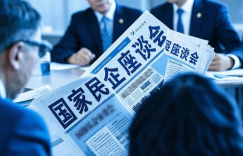
Today we are going to talk about an important tool for observing China’s economic signals, that is, how to judge whether the economic turning point will appear? This question is very complicated and there are many dimensions to observe, but since we are talking about policy trends, we will talk about how to see the signal of the economic turning point from the policy dimension. Simply put, before the economic turning point, we must first see the policy turning point, and before the economy hits the bottom and rebounds, we must first find the “policy bottom”. Let me explain it in detail.
The “Federal Reserve” transformation of policy expectation management
I don’t know if you have felt recently that high-level related meetings, press conferences of ministries and commissions, and the introduction of various policies have become more and more frequent.
For example, from September 24 to October 20, 2024, in just one month, there was a meeting of the Political Bureau of the Central Committee, three executive meetings of the State Council, a symposium of the Prime Minister, and more than 7 press conferences of the State Council Information Office. It is almost at a frequency of one every three or four days to actively communicate policies with the outside world.
In addition to the top leaders of the central government, the central bank, the Financial Regulatory Bureau, the China Securities Regulatory Commission, the National Development and Reform Commission, the Ministry of Finance, the Ministry of Housing and Urban-Rural Development, the Ministry of Justice, the State Administration for Market Regulation, and the Ministry of Industry and Information Technology also took turns to appear.
What does this phenomenon indicate?
In my opinion, this is an extremely critical change, that is, the expectation management of our country’s policies is becoming more and more “Federalized”.
As we all know, the Federal Reserve is very good at expectation management. When the market is in a period of divergence, the Federal Reserve will hope to “build consensus” and release signals through multiple channels to let the market understand the Federal Reserve’s policy intentions as early as possible, so as to adjust its own behavior in advance and reduce market volatility and policy shocks. When the market is in a period of emotional consistency, such as when everyone is enthusiastic, the Federal Reserve will pour cold water to “disperse consensus” and avoid the market from betting and speculating too much on monetary policy.
Two specific confirmations
The “Federalized” expectation management of China’s policies is not a trivial matter. What is reflected behind this is that the sensitivity of China’s policy system has been greatly improved. Simply put, our policies are responding to public concerns and public sentiment faster and faster.
We can give two examples to analyze.
The first example is that in August and September 2024, the difficulty of venture capital exit caused a great discussion.
On the one hand, the stock market IPO is tightened, and PE (private equity)/VC (venture capital) venture capital funds cannot exit through listing, and the shares cannot be cashed.
On the other hand, the fund expires, and a large number of investors demand to redeem the principal. In desperation, venture capital companies can only “turn against each other” and sue the companies they invested in, requiring the companies to immediately repurchase shares and return the investment according to the repurchase terms in the contract. According to statistics from Lifeng Law Firm, there are more than 130,000 entrepreneurial projects and about 8 trillion yuan of funds facing exit pressure and litigation risks. If it really turns into a stampede-style, run-style prosecution exit wave, we may lose a whole generation of entrepreneurs.
Fortunately, the policy responded immediately. At the State Council executive meeting in September, Premier Li Qiang made a series of arrangements to ease the venture capital stampede crisis, including relaxing IPOs for technology companies, vigorously promoting market mergers and acquisitions, promoting physical distribution of stocks, establishing regional equity transfer markets, vigorously promoting S funds, etc., which is to deal with the actual contradictions and accumulated emotions in the market. The response can be said to be very quick.
The second example is the policy’s response to the concerns and emotions of private enterprises.
Faced with the trade war, the impact of the epidemic, and the frequent debt explosions, private enterprises and entrepreneurs have been under great pressure. But the pressure does not only come from the decline in corporate revenue and profits. Since 2024, there have been several typical phenomena:
The first is that some local governments with financial difficulties have defaulted on their debts and owed accounts to private enterprises;
The second is that some local governments have a strong tendency to strictly enforce the law against enterprises and rely on fines to make up for the fiscal gap under the circumstances of fiscal austerity;
The third is that some local governments engage in profit-seeking law enforcement, reach out to economically developed areas, and enforce the law in other places in an irregular manner, freezing private enterprise accounts on the grounds of involvement in the case and taking away entrepreneurs. This kind of chaos is commonly known as “distant-sea fishing”.
These chaos have hit the market sentiment, as well as the confidence of the private economy and private entrepreneurs.
The central government quickly captured this information and responded – for example, from establishing a unified platform for clearing overdue accounts nationwide to strictly ordering local governments to restrain the behavior of “increasing revenue by fines”, to the direct public release of signals by the Prime Minister and the Director of the National Development and Reform Commission, requiring strict regulation of law enforcement in other places, followed by the introduction of the draft legislation of the “Private Economy Promotion Law”, which legally ensures everyone’s stable expectations for the safety and development of the private economy and private entrepreneurs.
In short, the above two examples reflect that the reaction cycle of policy signals is getting faster and faster.
From these things, we can make a summary:
Policymakers are paying more and more attention to the current market and public opinion trends, and even social emotions, and hope to eliminate negative impacts through timely and rapid responses, establish expectation orientation, and strive to achieve the same frequency resonance between policies and public expectations.
In other words, we can draw a conclusion: the bottom-up information transmission path is shortening, while the top-down policy response sensitivity is amplifying.
The key relationship between policy turning point and economic recovery
We have just talked about so many policy cases. What is the specific relationship with you? We further deduce that this is a very critical signal, that is, the policy system sensitivity is actually behind the policy turning point, in the words of stock investors, it is called “policy bottom”.
Given the political and economic system with Chinese characteristics and the huge role of its own policies, the policy turning point means the economic turning point to a considerable extent. This is a very important judgment. Although the policy turning point may not bring about the economic turning point quickly, without the policy turning point, it is basically impossible to foresee the economic turning point. Or in other words, at least there must be a policy turning point before you can expect the economic turning point.
The emergence of policy turning points, and the increasingly rapid concern and response to reality, often means a new round of easing. I emphasize again that the timely response to social concerns leads to increased policy sensitivity, and the result of increased sensitivity is often a new round of easing.
For example, after 2008, in order to save the economy from external shocks, the policy chose to relax land finance and allow local governments to raise funds by selling land and establishing urban investment.
If we look at it from today’s perspective, we will definitely feel that doing so at that time led to many problems later. But if we put it into the perspective of that time, we can actually find that the willingness to invest in all aspects was extremely low at that time, and all the money was blocked in the bank and unwilling to come out. It was precisely because of the policy shift to easing that the enthusiasm and initiative of local governments and various enterprises in the market were mobilized, and everyone was motivated to expand and invest, and the expansion investment slowly led the deposited funds out of the bank, and finally China took the lead in getting out of the global subprime mortgage crisis.
Back to the present, we are once again ushering in a policy turning point, or a policy bottom, and this time the easing will be a more comprehensive and high-dimensional easing, including monetary easing, enterprise-related public opinion easing, judicial easing, etc.
In addition, we can find that after each policy turning point appears, the next step is to find a handle. The handle in 2008 was the local government, which led the economy out of trouble through local government investment. The handle in 2014 was residents, who digested real estate inventory through residents’ purchasing power.
At present, I think that after the turning point of this policy, the most likely next step is enterprises, including state-owned enterprises and private enterprises. The former has been given many major strategic tasks, and the latter has recently been vigorously “promoted” and “activated” by policies, hoping to play a more critical role from the market end.
From the decision documents of the Third Plenary Session of the 18th CPC Central Committee to the recent draft of the “Private Economy Promotion Law”, the trend of providing key confidence and a stable environment for the private economy, releasing and stimulating its vitality, and then solving multiple problems such as technology, employment, and taxation through market vitality is becoming more and more obvious.
All this will bring some major impacts: because of the increase in policy sensitivity, the market’s attention and emotions can be reached faster, and the decisions and policies of the top leaders can also be transmitted to the market faster, bringing greater relaxation and vitality, and relaxation and vitality will eventually greatly optimize everyone’s “feeling”. Don’t underestimate this “feeling”. The improvement of “feeling” will more directly affect the market’s expectations and confidence restoration.
Only confidence can make China’s economic recovery truly come.



